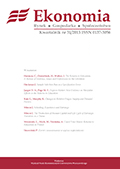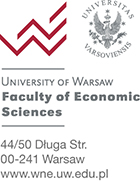Seminaria i konferencje
T. Odziemczyk, A. Różycka
ABSTRACT:
Full text (PDF)
Issue number: 13
In this issue:
Stabilizujące efekty pasma dopuszczalnych wahań kursu walutowego. Doświadczenia Polski z lat 1995–2000
P. Gierałtowski
ABSTRACT |
PDF
The objective of the paper is examination of the stabilizing effects of the system of creeping band of admissible exchange rate fluctuation that was in force in Poland in 1995-2000. According to the theory created by P. Krugman, such a system, if considered reliable by the participants of financial markets, can, by keeping the exchange rate expectations on the desired level, make a factor widening the degree of autonomy of the monetary policy, with simultaneous fulfilment of the existing exchange rate obligations.
The empirical analysis made and the adduced instances of cases in which the so-called stabilizing speculation has played a beneficial role permit to state that, especially in the second part of the period in question, the stabilizing effect of the band of admissible exchange rate fluctuations, together with the increased floating of the zloty, constituted an important element that enabled the National Bank of Poland to maintain a partial freedom in the conduct of monetary policy in the face of the steadily growing capital mobility.
Błędne fakturowanie jako reprezentacja „szarej strefy” w handlu zagranicznym Polski
M. Gruszczyński
ABSTRACT |
PDF
Misinvoicing can be one of the ways of evading the constraints on capital or current transactions in order to transfer profits, evade taxation or invest funds in markets to which the access is obstructed. The objective of this paper is to answer the following questions: can in the Polish foreign trade a hidden outflow or rather inflow of capital by means of misinvoicing be observed? which are the directions of the capital flows that might be attributed to misinvoicing and which can be the transmission channels of the relevant capital (and trade transaction) flows from and to Poland?
Wiedza - interpretacja infologiczna
B. Stefanowicz
ABSTRACT |
PDF
The article presents an infological approach to explain the sense of the term knowledge. Originally, the idea of such an approach was developed by Bo Sundgren (1973) and Börje Langefors (1980) to define the term information. The concept was based on the assumption that information can be viewed as a name of the context delivered by the message K defined according to (1). By analogy, the term knowledge w can be interpreted as the contents of the set consisting of three elements (2), information I, context (C) of the problems Q under solving, and the experience (D) of the user U. The approach seems to be perspective for manifold analysis of knowledge. Among others, w can be considered as a name of the relation combining the elements in (2), which makes a good background for developing a relational theory of knowledge.
Metoda r - substytutem metody najmniejszych kwadratów
I. Timofiejuk
ABSTRACT |
PDF
The subject of this paper was presentation of the properties of the Method r, i.e. a method utilizing the sum of the terms of a real time series in calculating the average (mean) of the growth pace (rate). This property permits to use the Method r and its tables as substitute for the Least Square Method in fitting the time series wherever an exponentialtype function is to be adjusted to real (experimental) data. The solution of the problem was presented in two variants: a) real initial (basic) term and real sum of terms of the time series in question; 2) real final term and real sum of terms of the time series in question.
Dobra publiczne w usługach finansowych
J. Solarz
ABSTRACT |
PDF
Gap between governmental spending and governmental ownership in financial sector is one of the main barriers in progress of public finance reforms in Poland. Only clear dividing of financial services on public and private goods and same fuzzy semi-public goods can define scope of governmental presence in our financial service.
Zróżnicowanie aspiracji zawodowych młodych pracowników w Polsce - wnioski na podstawie danych BAEL
J. Kudła, P. Modzelewski
ABSTRACT |
PDF
The purpose of this article is to assess the proper length of the educational period which is consistent with occupational aspirations of young people, considered as a kind of effectiveness. In order to establish the results we use data envelopment analysis (DEA) and data collected from chosen respondents of Labour Force Survey (in polish BAEL). In general, the most ineffective appeared tertiary education level, by which we mean its educational time can be harshly reduced without lost of effectiveness or, in other words, the occupational aspirations of young people are not fulfilled, especially for themost educated. We have found also the differences in effectiveness between divisions of economic activity coherent with financial conditions.
Wpływ czynników demograficznych na sytuację polityczno-ekonomiczną Arabii Saudyjskiej
A. Łukaszewicz
ABSTRACT |
PDF
The objective of the paper is to show the relationships existing between the demographic situation and the political and economic condition of Saudi Arabia. The author draws attention to the growing effect of rapid demographic increase that, combined with the inadequate government policy, leads to massive unemployment and, in the longer run, multiple tensions in the country's economy and policy. The paper critically assesses the economic policy instruments applied by the state aimed at limiting the scale of unemployment, such as: the reform of the educational system and the programme of promoting the employment of local population in place of foreign workers, i.e. the socalled Saudization Programme.
Samodzielność ekonomiczna i finansowa jednostek samorządu terytorialnego
M. Jastrzębska
ABSTRACT |
PDF
Implementation of the country's decentralization and democratization processes requires definition of the territorial selfgovernment's independence, while the determinants of the independence of the territorial selfgovernment units (TSGU) that define its kind and scope can be divided into systemic, economic, social, political and legal ones. The research on the territorial selfgovernment's independence conducted in formal terms consists in analysing the relationships between the state and the territorial selfgovernment as well as between the TSGU units and the agencies that constitute the internal structure of the selfgovernmental economy. Whereas the territorial self-government's independence in substantive terms can be considered in relation to: the sphere of real activity, i.e. social and economic activity (tasks to be carried out) and the financial sphere, i.e. the selfgovermental financial policy (the financial resources at disposal versus the tasks the and powers to implement those tasks). The basic condition of territorial selfgovernment units' independence is their financial independence (i.e. the income, expenditure and budget independence as well as the capacity to contract debts), because he who has money is the one who rules.
Weryfikacja hipotezy o "środowiskowej krzywej Kuznetsa" na przykładzie emisji dwutlenku węgla w krajach OECD
A. Kukla-Gryz
ABSTRACT |
PDF
According to the "Environmental Kuznets Curve" (EKC) hypothesis, the level of pollutant emission grows along with the initial stage of economic development and, then, diminishes with further economic development. Usually, the EKC hypothesis is explained by three effects: the scale effect, the structure (or composition) effect and the income effect.
In this paper, a verification of the EKC was undertaken basing on the example of the carbon dioxide emission by the industry in the OECD countries, this time the attention being concentrated on two less popular effects: the .shock. effect and the effect related to the "pollution heaven hypothesis" ("dirty production migration" effect). As an example of shock the petroleum crisis of the seventies was chosen. The verification results showed a substantial impact of the petroleum crisis on the change in carbon dioxide emission by the industry and, at the same time, unimportance of the "pollution heaven" effect.
Rozwój społecznego budownictwa czynszowego w Polsce
A. Białek-Jaworska
ABSTRACT |
PDF
The article describes a genesis of Social Building Societies in Poland starting from National Housing Fund through Workers Housing Estates Society in 1934.1939, announcement of cheap building system in New Housing Order in 1993 to Barbara Blida's and Irena Herbst's legislative initiative leading to establish Social Building Societies in 1995.
According to International Permanent Social Building Committee social housing consists in supply houses with fixed minimum standard of comfort and equipment, for rent or sale for persons who can not afford a house at market price without assistance of state or social organizations. In Poland Social Building Societies can not supply houses for sale but only for rent. State assistance in supplying houses for rent consists in establishing purposeful fund and providing it with financial means to allow credits on preferential conditions. National Housing Fund allows Social Building Societies large, cheap and long term credits, bearing interest at a half rediscount rate in NBP but not lower then 4,5%. Social Building Societies solve housing shortage problem by transformation of existing housing needs in demand, anticipating average households future incomes to pay off credit during almost 30 years. Social Building Societies are like a hybrid, because they have to fulfil social mission as well as maximise financial profit from their activity. Construction of Social Building Societies lead to creation of a closed market on which Social Building Societies play on demand side on building market as well as on supply side on housing market. In the article the author describes Social Building Societies. activity from legal side as well as on financial side including status, organization forms, territorial location, financial source for their activity, rent policy, housing assets management, SWOT analysis and criteria of Social Building Societies investment projects evaluation.
Podatek akcyzowy w Polsce i jego znaczenie fiskalne
J. Śmiechowicz
ABSTRACT |
PDF
Despite its selective nature, the excise duty is one of themost effective sources of the state budget revenues. A fundamental influence on the receipts from this source is exercised by: the kinds and number of articles recognized as excisable and the volume of their sales in the country and of their imports, the excise duty rates, the extent of granted allowances and exemptions, as well as the efficiency in collecting the revenues from this duty.
The range of excise duty applicability is very large and covers a great number of articles, many of them of no significant fiscal importance. At the same time, the list of allowances and exemptions introduced both by acts of Parliament or by ordinances of government bodies is excessively extended. The bulk of revenues obtained from the excise duty comes from taxation of alcoholic beverages, tobacco articles and fuels, while the source of greatest importance is the duty on domestic sales of goods that, in 1994-2001, provided on average 87.7% of the total excise duty revenues. The taxation of imports played a much smaller role.
The rates of excise duty burden are relatively high and since the start of their functioning have been many times modified. However, in recent years a trend towards stabilizing the excise duty rates, and even towards reducing some of them, can be observed.
Excessive excise rate duties led to deterioration in the condition of the spirits, wine and tobacco branches. Financial difficulties of some firms, especially those producing alcoholic beverages, led to accumulation of arrears in the discharge of their excise duty liabilities and to remission of a part of their indebtedness on that score.
The excise duty is a flexible source of budget revenues and it is the Minister of Finance who plays the role of the main author of the state's policy in this area. He has broad powers in shaping the rates and introducing the allowances and exemptions and, consequently, in shaping the revenues from the excise duty. The excessive authority of the Minister of Finance and the use of excise duty as a source of additional revenue whenever the budget is in critical situation is often subject for criticism.

